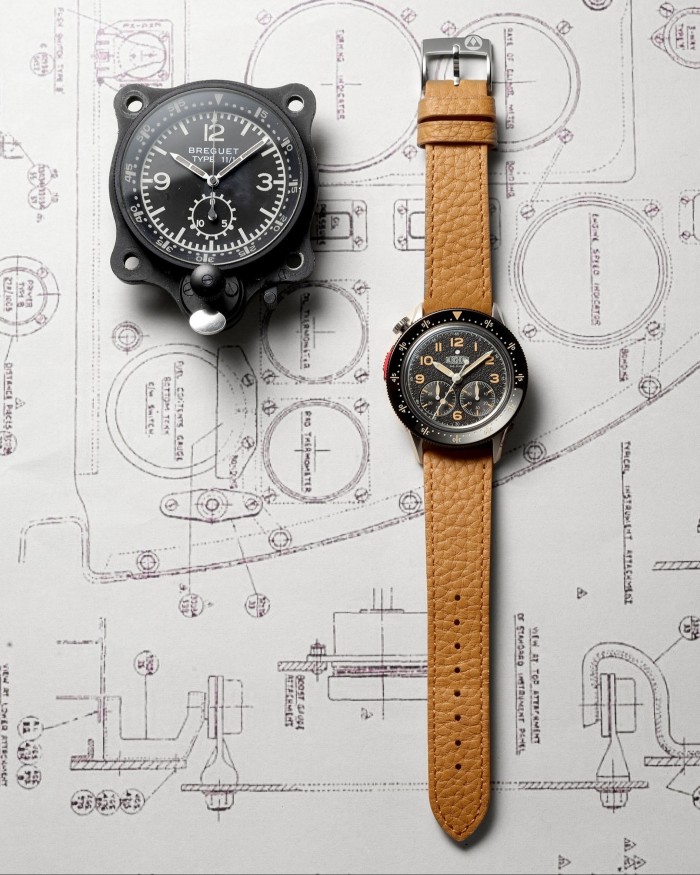Albishorn aims to redefine retro with ‘what-if’ watches

It has taken him four years and half a million Swiss francs of his own money but, at last, after almost two decades in the industry, Sébastien Chaulmontet has his own watch company.
Albishorn, named after a Swiss peak 20km south of Zurich, was announced at the end of August. Since then, it has introduced two chronograph watches inspired by what Chaulmontet calls an “imaginary vintage” aesthetic.
“I always dream of finding something I haven’t seen before at a flea market,” says Chaulmontet, 49, who once co-authored a book on collecting chronographs. “I decided that, if I was ever to do this, I would try to make the missing watches — stuff that could have been but never was.”
He says Albishorn’s first watch, the Maxigraph, was inspired by Le Bol d’Or, a yacht race first held on Lake Geneva in 1939. “It’s a quirky product, playful but weird,” he says. “Most people would settle for a re-edition [of an old watch] but, like a fake Rolex you buy on holiday, at the end of the day, you don’t own a Rolex.”
Albishorn’s second watch followed in October. The Type 10 is an imagined 1940s predecessor to the Type 20 pilot’s watches developed for the French military in the 1950s by brands including Breguet, which continues to reflect the aesthetic in its classic Type XX chronograph.

Chaulmontet says the Albishorn project took him longer than he expected because he and his head of design, Fabien Collioud, were creating vintage watches that never existed. “If you want to create something new [but vintage-looking], you have to understand the fonts and the proportions,” he says. “Watches not made in Switzerland often use our codes, but the makers don’t understand them. I wanted to use our grammar, but be creative, which is where the idea came from.”
He says he has another six or seven models in development. These include a hypothetical piece called the Thundergraph, that might have been created for the Swiss climbers who tried but failed to reach Everest’s peak in 1952, and the Spatiograph, a watch that could have been designed to go into space in the 1960s, had Nasa not selected Omega’s Speedmaster for its space programme. “The list of what I can do is already long,” he says. “It could survive me.” Chaulmontet is so fixated on his “imaginary vintage” concept that he secured a registered trademark for it. “It may be over the top, but I could do it, so I did,” he says.
Both watches released so far are priced between £3,500 and £4,000, which some online commentators have described as too high, given that their movements are based on the readily available Valjoux 7750 chronograph. But Frank Geelen, founder of online watch magazine Monochrome, disagrees. “The price for something this original is not crazy,” he says, adding that both movements have been heavily adapted and improved. “They also made a custom case and pusher, and they won’t be making thousands of them, so the margin for a small batch will be tighter.”
Albishorn may be new to watchmaking, but Chaulmontet is not. Having originally trained as a lawyer and written his doctorate on environmental liabilities, he gave up a promising career with Bär & Karrer, a Zurich law firm, and went to work for the Swiss specialist watch movement company La Joux-Perret. He had long been fascinated by watchmaking and had taught himself how to design both a watch and its mechanical movement, even filing a number of patents for his technical developments, including one for a constant force mechanism — a complex system relating to how a watch uses its power.
He left in 2017 to become head of innovation and marketing at Sellita, another Swiss movement specialist and one of the largest suppliers of third-party calibres to watch companies all over the world. While at La Joux-Perret, he also oversaw the product and innovation strategies that drove the revivals of legacy watch companies Arnold & Son and Angelus. Chaulmontet remains at Sellita, where he works four days a week. “I’m happy at Sellita and don’t expect to leave any time soon,” he explains.
The Maxigraph was created in collaboration with William Rohr, better known as William Massena, founder of the watch creation studio Massena LAB, which has previously collaborated with Louis Erard, Unimatic, Angelus and H Moser & Cie. “I’ve been a fan of Sébastien for more than a decade,” says Rohr. “He’s a renaissance man, the Swiss pocketknife of watchmaking. When he told me about his what-if watches, I thought it sounded really interesting.”
Chaulmontet and Rohr both say Albishorn will not become a volume brand. “This year, I may get to 140 watches,” says Chaulmontet, adding that he has committed to producing batches of 25 of each of the Type 10, but that it will not be limited. “If I get to 200 a year, I will be happy because I don’t want to grow bigger than that.” He says he owns 100 per cent of the company, has no plans to seek investment, and that his forecasts mean it will take him five years to recoup his investment.
“Volumes don’t create value, except in profits,” says Rohr, noting the Maxigraph’s left-hand crown and chronograph pusher, patented 10-minute retrograde regatta countdown function, and proprietary movement designed by Chaulmontet that reduces the thickness of the overall watch by 15 per cent. “This is niche of niche, not a blockbuster. It’s a watch for people who appreciate vintage and small complications,” Rohr says.
With the industry in a downturn, veteran watch commentator Kristian Haagen says Albishorn is doing the right thing to attract buyers. “Brands old and new need to come up with carefully curated designs that lure clients into the net,” he says. “Look at [new brands] Berneron and Gaga Laboratorio. Now is the time for shapes, for something different.”
#Albishorn #aims #redefine #retro #whatif #watches






